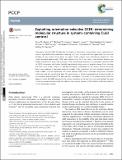Files in this item
Exploiting orientation-selective DEER : determining molecular structure in systems containing Cu(II) centres
Item metadata
| dc.contributor.author | Bowen, Alice M. | |
| dc.contributor.author | Jones, Michael W. | |
| dc.contributor.author | Lovett, Janet E. | |
| dc.contributor.author | Gaule, Thembanikosi G. | |
| dc.contributor.author | McPherson, Michael J. | |
| dc.contributor.author | Dilworth, Jonathan R. | |
| dc.contributor.author | Timmel, Christiane R. | |
| dc.contributor.author | Harmer, Jeffrey R. | |
| dc.date.accessioned | 2016-03-11T14:30:04Z | |
| dc.date.available | 2016-03-11T14:30:04Z | |
| dc.date.issued | 2016-02-28 | |
| dc.identifier | 241557862 | |
| dc.identifier | bab59f5d-bae1-4c25-82a6-07e71ed19093 | |
| dc.identifier | 84959036610 | |
| dc.identifier | 000371953000032 | |
| dc.identifier.citation | Bowen , A M , Jones , M W , Lovett , J E , Gaule , T G , McPherson , M J , Dilworth , J R , Timmel , C R & Harmer , J R 2016 , ' Exploiting orientation-selective DEER : determining molecular structure in systems containing Cu(II) centres ' , Physical Chemistry Chemical Physics , vol. 18 , no. 8 , pp. 5981-5994 . https://doi.org/10.1039/c5cp06096f | en |
| dc.identifier.issn | 1463-9076 | |
| dc.identifier.other | ORCID: /0000-0002-3561-450X/work/40301301 | |
| dc.identifier.uri | https://hdl.handle.net/10023/8406 | |
| dc.description | We gratefully acknowledge financial support from the EPSRC, BBSRC and Royal Society. JRH thanks the ARC (FT120100421) for financial support. JEL and AMB would like to thank University College, Oxford for financial support. JEL would also like to thank The Royal Society for a University Research Fellowship. TGG and AMB were supported by a BBSRC studentships. | en |
| dc.description.abstract | Orientation-selective DEER (Double Electron-Electron Resonance) measurements were conducted on a series of rigid and flexible molecules containing Cu(ii) ions. A system with two rigidly held Cu(ii) ions was afforded by the protein homo-dimer of copper amine oxidase from Arthrobacter globiformis. This system provided experimental DEER data between two Cu(ii) ions with a well-defined distance and relative orientation to assess the accuracy of the methodology. Evaluation of orientation-selective DEER (os DEER) on systems with limited flexibility was probed using a series of porphyrin-based Cu(ii)-nitroxide and Cu(ii)-Cu(ii) model systems of well-defined lengths synthesized for this project. Density functional theory was employed to generate molecular models of the conformers for each porphyrin-based Cu(ii) dimer studied. Excellent agreement was found between DEER traces simulated using these computed conformers and the experimental data. The performance of different parameterised structural models in simulating the experimental DEER data was also investigated. The results of this analysis demonstrate the degree to which the DEER data define the relative orientation of the two Cu(ii) ions and highlight the need to choose a parameterised model that captures the essential features of the flexibility (rotational freedom) of the system being studied. | |
| dc.format.extent | 14 | |
| dc.format.extent | 4304666 | |
| dc.language.iso | eng | |
| dc.relation.ispartof | Physical Chemistry Chemical Physics | en |
| dc.subject | QC Physics | en |
| dc.subject | Physical and Theoretical Chemistry | en |
| dc.subject | Physics and Astronomy(all) | en |
| dc.subject | DAS | en |
| dc.subject.lcc | QC | en |
| dc.title | Exploiting orientation-selective DEER : determining molecular structure in systems containing Cu(II) centres | en |
| dc.type | Journal article | en |
| dc.contributor.sponsor | The Royal Society | en |
| dc.contributor.institution | University of St Andrews. School of Physics and Astronomy | en |
| dc.contributor.institution | University of St Andrews. Biomedical Sciences Research Complex | en |
| dc.identifier.doi | https://doi.org/10.1039/c5cp06096f | |
| dc.description.status | Peer reviewed | en |
| dc.identifier.grantnumber | UF090121 | en |
This item appears in the following Collection(s)
Items in the St Andrews Research Repository are protected by copyright, with all rights reserved, unless otherwise indicated.

